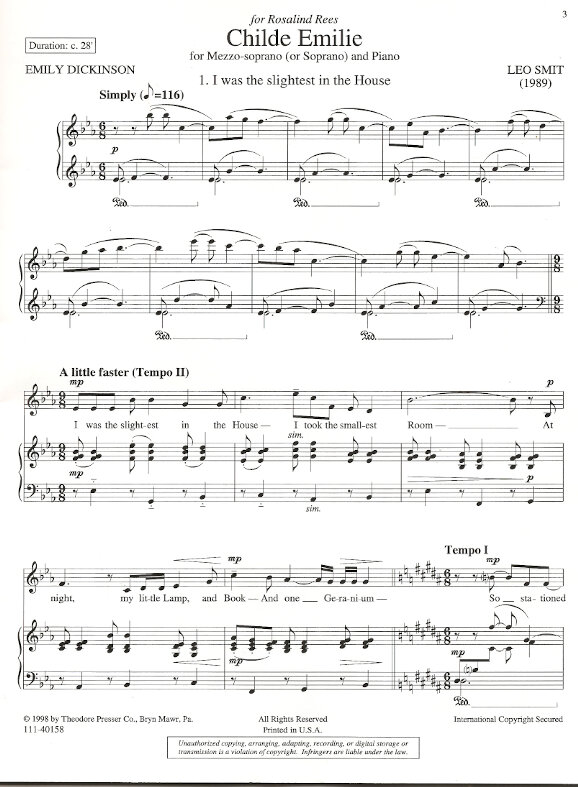Leo Smit's Dickinson Songs
The first page of the first song of the first cycle, "Childe Emilie"
"I was the slightest in the House" from Childe Emilie
Rosalind Rees, soprano/Leo Smit,piano (BRIDGE 9080)
When Leo Smit began composing songs on poems of Emily Dickinson in 1989, perhaps not even he had an idea of how large an undertaking he had embarked upon. While he had written a substantial amount of vocal music throughout his life, including a full-evening opera and recently had completed a twenty minute song cycle, “The Dwarf Heart” (1987), on poems of Anne Sexton, there was nothing in his output to suggest the extraordinary outpouring of music that eventually became “The Ecstatic Pilgrimage”, seventy-six songs grouped into six cycles. The six cycles and their thematic links are:
Cycle I: Childe Emilie (memories and fantasies of childhood) 14 songs
Cycle II: The Celestial Thrush (music and birds) 12 songs
Cycle III: The Marigold Heart (love,loss, and renunciation) 15 songs
Cycle IV: Beyond Circumference (death,faith and immortality) 18 songs
Cycle V: Tinted Mountains (light and landscape) 10 songs
Cycle VI: The White Diadem (poetry and poets) 7 songs
Some sense of Leo’s creative excitement is indicated by the dates of composition at the end of the manuscripts. The first song in the first cycle, “I was the slightest in the House” is dated 3/8/89, then what becomes the sixth song, “I cried at Pity-not at Pain” is dated 3/12/89. Within less than two months all the songs had been composed except the last, which was completed 7/15/89. Many of the songs were composed in one sitting, the union of words and music immediately felt and accomplished. Leo’s immersion into the world of Dickinson was total. He had found a soulmate.
Five of the six cycles are recorded and available on Bridge Records. Cycles I,II and VI are performed by Rosalind Rees and Leo (Bridge 9080); Cycles II and IV by Georgine Resick and Warren Jones (Bridge 9227). Cycles I and VI are published by Theodore Presser. The other four cycles are available through Theodore Front Music in engraved, composer supervised, editions.
In my notes to the Resick/Jones recording I wrote about the songs:
“In listening to them one is struck by their consistency, They get right to the text. While there are some that set up quite elaborate and pictorial piano figuration at the start (“Wild Nights”, for example), most of them quickly establish a simple piano/vocal relationship and then proceed to investigate an intervallic/registral patterning which takes place in the realm of very abstract composition. It isn’t that the words aren’t illustrated or inflected, but there is something else pushing the music forward, and that is the unleashing of a creativity no longer concerned with historical or even personal self-consciousness. The songs are about the satisfaction of finding the notes in the words.”
